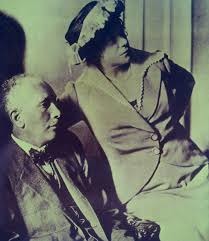
Richard and Pauline Strauss
They meant that Bach could put his name into his music simply as B-A-C-H (B-flat-A-C-B natural). But, what if you were in love and wanted to signal something to your beloved – immortalize her in music? If you’re Robert Schumann and involved with someone with the un-convertible name of Ernestine von Fricken (too many letters not in the scale), you look at the name of her town: Asch (A-E-flat-C-B-natural) and you use it as the basis for your piece, Carnaval, op. 9. And then, being Schumann, you notice that, shifted around, those letters are also in your name: S-C-H-A and also use that in Carnaval.
Carnaval: No. 10. ASCH – SCHA (Lettres dansantes)
Alban Berg paired his initials A-B with that of his mistress, Hanna Fuchs-Robettin (A-F) in his Lyric Suite.

Ernestine von Fricken
Theme and Variations on the name Abegg, Op. 1
It was Richard Strauss, however, who immortalized not only his wife Pauline in the 1903 Symphonia Domestica but also his child and extended family. Pauline is represented not as a coded melody but with different themes depicting her personality. The entire tone poem represents, as Strauss noted, “a day in my family life. It will be partly lyrical, partly humorous – a triple fugue will bring together Papa, Mama and Baby.” As an autobiographical work, each participant has their own theme; a 1904 analysis summarized these as:
The husband’s themes: (a) Easy-going; (b) Dreamy; (c) Fiery
The wife’s themes: (a) Lively and gay; (b) Grazioso
The child’s theme: Tranquil
The Adagio contains the famous love scene that shows Pauline’s theme above that of the composer’s – for many listeners, this was a bit too autobiographical! For more on the beloved but ever-exasperating Pauline, see an earlier article in Interlude.
Symphonia domestica, Op. 53, TrV 209
Part I: Adagio (Langsam)
Next time we’ll take on the reverse of the Immortalized Beloveds: the Immoral Beloveds who didn’t love their composer spouses as much as we do now and caused all sorts of problems in their lives. Burned manuscripts and discarded lovers were the least of it!
